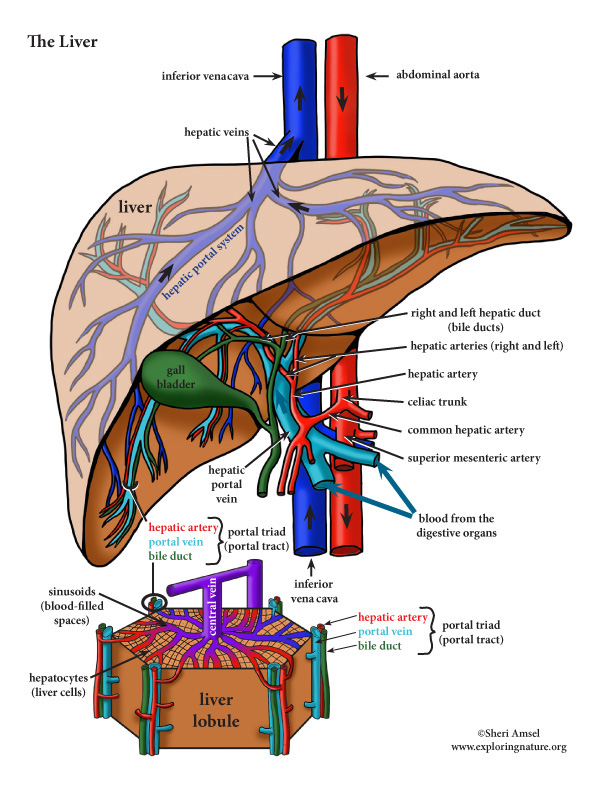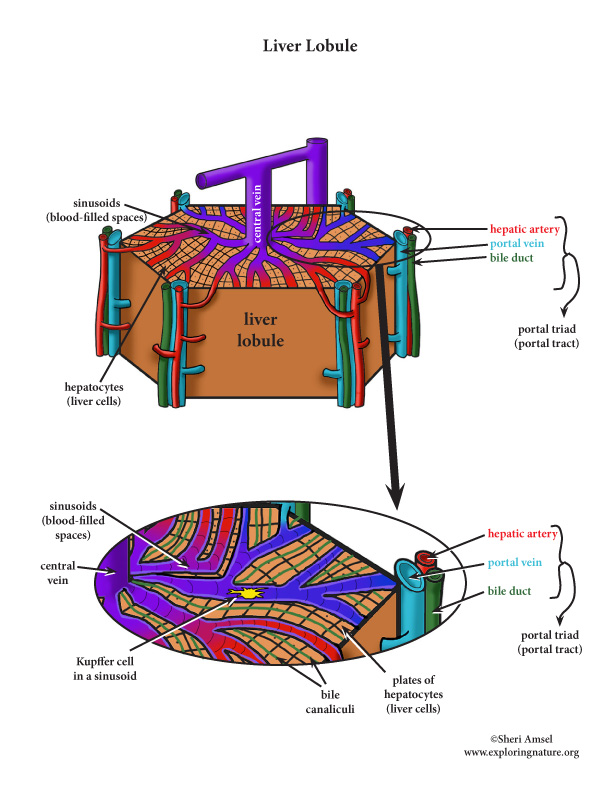

Liver Structure:
The liver has four lobes which are made up of smaller lobules. The liver’s lobules are its functional units.
Each lobule is a hexagon shape made up of plates of hepatocytes (special epithelial cells).
The plates of hepatocytes radiate outward from a central vein. Through them is a canal where the bile they produce flows outward into the triad’s bile duct. The canals are called bile canaliculi.
At each of the 6 corners of the hexagon-shaped lobules is a triad of vessels, including:
• hepatic artery (brings arterial blood to the actual liver tissue)
• portal vein (brings venous blood to the liver to be filtered)
• bile duct (delivers bile for fat emulsification)
Between the hepatocyte plates are sinusoids (blood-filled spaces). The sinusoids are lined with special phagocytic cells, called Kupffer Cells. Blood from the hepatic portal vein and the hepatic artery filters through the sinusoids from the triads to the central vein. The Kupffer Cells absorb the blood waste as it passes in the blood.
The liver is one of the most important organs of the body.
It’s functions include:
1) Receiving venous blood from the digestive tract (oxygen poor but nutrient rich) via the portal vein, which and is then filtered.
2) The liver makes bile (more specifically: it’s hepatocyte cells make bile). Bile is a fat emulsifier. Bile breaks down fats so that they can be absorbed into the blood in the small intestine.
2) The liver stores glucose as glycogen and coverts the glycogen back to glucose when the body needs it.
3) The liver filters alcohol and drugs from the blood (detoxifies).
4) The liver stores fat-soluble vitamins (Vit. A, Vit. E, Vit. D, and Vit. K).
5) The liver reuses iron in old, worn out red blood cells before breaking them down.
6) The liver converts ammonia in to urea (which the body can use).
7) The liver’s cells (hepatocytes) use amino acids to make plasma proteins.
When you research information you must cite the reference. Citing for websites is different from citing from books, magazines and periodicals. The style of citing shown here is from the MLA Style Citations (Modern Language Association).
When citing a WEBSITE the general format is as follows.
Author Last Name, First Name(s). "Title: Subtitle of Part of Web Page, if appropriate." Title: Subtitle: Section of Page if appropriate. Sponsoring/Publishing Agency, If Given. Additional significant descriptive information. Date of Electronic Publication or other Date, such as Last Updated. Day Month Year of access < URL >.
Amsel, Sheri. "Liver Structures and Functions - A Closer Look (Advanced)" Exploring Nature Educational Resource ©2005-2024. December 13, 2024
< http://www.exploringnature.org/db/view/5165 >

